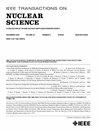中国三颗卫星与GPS ns70和ns71高能电子通量的在轨交叉定标
IF 1.9
3区 工程技术
Q3 ENGINEERING, ELECTRICAL & ELECTRONIC
引用次数: 0
摘要
交叉校准来自不同卫星的高能电子通量测量值对于了解地球辐射带的动力学和空间辐射环境的建模至关重要。本文对中国三颗中地球轨道卫星(M17、M18和M19)和两颗全球定位系统卫星(ns70和ns71)测量的高能电子数据进行了标定和分析。以L和磁地方时(MLT)作为分形标准,MEO卫星与GPS卫星之间存在较强的相关性和一致性。我们表明,这些卫星上的探测器的测量结果基本相同,在对数尺度上最大差异为22%。最后,基于相空间密度(PSD)的简单校准提高了MEO卫星与GPS之间的相关性和一致性,在对数尺度上将最大差值降低到2%。它还表明,这些卫星非常接近精确的范艾伦探测器(VAPs),因为GPS在之前的研究中已经由它们校准过。这将有助于填补MEO的重大数据空白,并为辐射带核心区(L ~ 5)内粒子动态变化提供重要的见解。预期非科学卫星提供的数据将会增加,为科学研究提供一套更全面的多点测量数据。本文章由计算机程序翻译,如有差异,请以英文原文为准。
On-Orbit Cross Calibration of Energetic Electron Flux Measurements From Three Chinese Satellites and GPS ns70 and ns71
Cross calibration of energetic electron flux measurements from different satellites is essential for understanding the dynamics of the Earth’s radiation belts and for modeling the space radiation environment. In this article, we calibrate and analyze the energetic electron data measured by three Chinese medium Earth orbit (MEO) satellites (M17, M18, and M19) and two global positioning system (GPS) satellites (ns70 and ns71). Strong correlations and consistencies were found between the MEO satellites and GPS satellites using L and magnetic local time (MLT) as binning standards. We show that the measurements from the detectors onboard these satellites are basically the same with a maximum difference of 22% on a logarithmic scale. Finally, a simple calibration based on phase space density (PSD) improves the correlations and consistencies between MEO satellites and GPS, reducing the maximum difference to 2% on a logarithmic scale. It also showed that these satellites are very close to the precise Van Allen probes (VAPs) since GPS had been calibrated by them in a previous study. This will help to fill the significant data gap in MEO and provide crucial insights into particle dynamic variations within the core region (L ~ 5) of radiation belts. It is expected that the availability of data from non-scientific satellites will increase, providing a more comprehensive set of multipoint measurements for scientific research.
求助全文
通过发布文献求助,成功后即可免费获取论文全文。
去求助
来源期刊

IEEE Transactions on Nuclear Science
工程技术-工程:电子与电气
CiteScore
3.70
自引率
27.80%
发文量
314
审稿时长
6.2 months
期刊介绍:
The IEEE Transactions on Nuclear Science is a publication of the IEEE Nuclear and Plasma Sciences Society. It is viewed as the primary source of technical information in many of the areas it covers. As judged by JCR impact factor, TNS consistently ranks in the top five journals in the category of Nuclear Science & Technology. It has one of the higher immediacy indices, indicating that the information it publishes is viewed as timely, and has a relatively long citation half-life, indicating that the published information also is viewed as valuable for a number of years.
The IEEE Transactions on Nuclear Science is published bimonthly. Its scope includes all aspects of the theory and application of nuclear science and engineering. It focuses on instrumentation for the detection and measurement of ionizing radiation; particle accelerators and their controls; nuclear medicine and its application; effects of radiation on materials, components, and systems; reactor instrumentation and controls; and measurement of radiation in space.
 求助内容:
求助内容: 应助结果提醒方式:
应助结果提醒方式:


